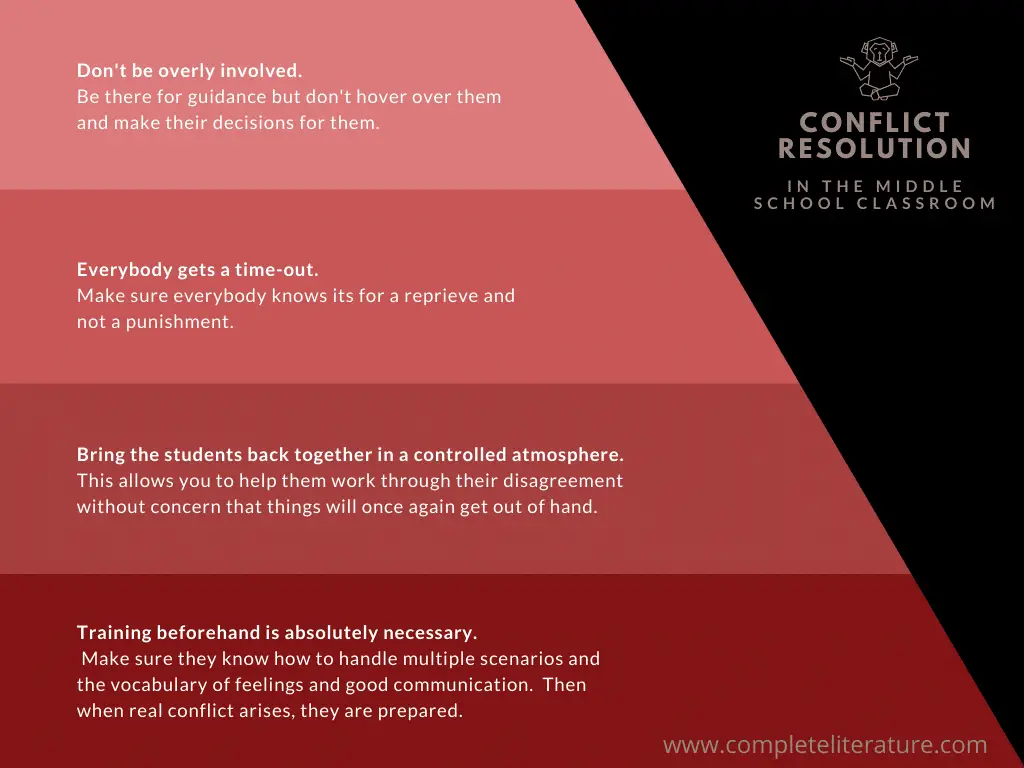
Middle schoolers like to fight. They like to argue. And they especially like to prove themselves right. Conflict resolution is certainly not on their mind, although conflict surely is. But as much as they seem to like to argue, they do not love conflict or feeling like people do not like their thoughts or behavior.
It is such a tricky age. And it makes sense that conflict is so normal for this age. They are just starting to see the big picture in life. They want to be old enough or big enough to navigate it, but they aren’t. And they are in an awkward in-between stage that makes many decisions difficult for them. Add difficulties in relating to others to the mix and life gets very difficult very quickly.
Table of Contents
The Short Answer
So how do we help our students out with conflict resolution in the middle school classroom? Conflict resolution in middle school is primarily a product of two things: communication skills and emotional maturity. And believe it or not, kids as well as adults can learn to navigate these issues and thrive through them.
There is, unfortunately, a lack of training in conflict resolution. This bears out in the home as well as at school. Maybe part of the reason for that is that as adults we are not all especially skilled at it ourselves.
As teachers, we have an incredible opportunity to teach these valuable life skills in a setting that can be non-confrontational and educational. And we can teach them in a way that they will be given a skill set that they will use for life.
Let’s take a look at what conflict resolution looks like in the middle school classroom. And we’ll look at some great strategies you can exercise yourself and teach your students.
So with that, here we go.

Don’t Be Overly Involved
So notice I said “don’t be overly involved,” not “don’t be involved” or “be very involved.” We can find a happy medium here that is actually a necessary medium. We need the kids to learn and grow through conflict but we also need them to survive emotionally and physically though conflict as well.
It presents a great opportunity to give the kids a chance to resolve conflicts on their own. But generally speaking, that is not the case. Sometimes they are able to come to an agreement. But far more often, the argument either escalates, one child bullies the other into submission, or they both give up and end up holding grudges or behaving out of the hurt feelings that have not been resolved on either side.
On the other hand, we have to be very careful not to step in every time we hear a cross word spoken. If we coddle them through every argument or disagreement, we will never get them to understand the process of conflict resolution. And they will never be able to grow through it and grow in their relationships with others.
How This Plays Out
So where to we find our happy medium? To start, as soon as you hear the first hint of disagreement, try to listen from afar so that the whole class doesn’t get interrupted and the kids in conflict don’t instantly rely on you to resolve their issue. It is good for them to at least begin to work on their communication and empathy skills while still being assertive enough to explain how they feel and why.
Give both sides a chance to hear each other. As long as they are being respectful to each other and seeming to hear and work through what is being said, the better to leave them. They are doing great!
But when things start to go downhill, it is good to step in. You don’t want it to escalate beyond what you can comfortably resolve.
And that takes us to the next point.
Everybody Gets a Time-out
This is not for the sake of punishment, so be careful to not allow the kids think that it is. Just explain that everybody needs a minute to cool down so that we can resolve this appropriately.
This may be one of the best lessons you can teach your middle schoolers. They are learning that it is just fine to take a step back. That makes them able to think about what is going on. Most often, they will appreciate the instant “refresh” that will allow them to clear their heads and proceed in a much calmer manner. Even middle schoolers can appreciate this because they don’t necessarily want to cause a huge scene. They want to be heard.
Depending on what is going on in class at the moment, you may have the ability to speak to each person separately. This is especially true if you still need to fill in gaps in your understanding of the situation. You must be very careful not to make judgments based on a limited knowledge of the situation.

Working out the Logistics of the Time-out
You may have no idea what happened in the minutes leading up to the exchange that totally changed the situation. In fact, it would be very rare to have a full understanding of most situations that arise. The reason for this is because you are generally not going to be there to hear how the conversation or event started that caused the rift in agreement.
It is always good to get the perspective of each of the kids involved. And this is the tough part for all of us: you need to be empathetic to all sides without taking any sides.
There will be cases where you cannot take care of the situation immediately without disrupting what you are doing. Let them know you will help them work this out on the next break. But make sure that they aren’t left hanging. When you leave kids stewing in their anger and frustration for a long time, a lot of damage can be done.
How This Plays Out
As soon as you get an opportunity, take a minute or two to get each person’s perspective. That should give you the ability to think through what is going on. It is definitely the best way to take care of it.
The benefit to all of this is that by physically diffusing the situation, you are almost instantly helping tempers to calm down.
And that helps us get to our next point.
Bring the Students Back Together in a Controlled Atmosphere
Now everybody has had a chance to cool down for a bit. So we can actively work on the conflict resolution. At this point in time, you got a chance to hear the sides of each of the people involved. And hopefully at this point, they also feel that they have been heard. You want them to feel safe with you, regardless of what your position is regarding the matter being discussed.
You don’t want to take a huge amount of time in this step, or in the whole process. After all, you do have a class to teach.
Exercising Good Communication Skills
The next thing you want to do is let each person express their issue. Then let the other one (or other ones if more than two are involved) repeat back what they heard the first person to say. This assures the speaker that they have been heard and understood. Once everybody has had their chance, you can now start guiding them towards showing some empathy and working together to find a solution.
Asking them the relevant questions to get them to be in agreement should get you all set. Of course, once in a while you may have two or more very stubborn students who decide that they are not going to work things out no matter how well arguments are made. In those cases, don’t prolong the fact that they are just going to continue to give you a hard time. Middle schoolers can also be very good at stubbornness. But that is a subject for another article.
Training Beforehand is Absolutely Necessary
In order for conflict resolution in the middle school classroom to work, you must practice and master it with the students before it becomes necessary. It is really the best way to go.
If they already know how to work out disagreements in various issues that have come up in practice, they will be able to get through it pretty quickly and easily when it is the real thing.
What That Training Looks Like
Make sure that your practice sessions cover a wide range of scenarios. They don’t need to be more than a couple of minutes–make it a 5 minute filler between classes or as an ice breaker as they arrive. The more different things they get used to handling in practice, the more easily they will be able to quickly and efficiently solve the real thing as it come up.
There is one more thing you need to do to make sure they can do in practice. They need to be able to accurately evaluate and describe how they feel. Having a small bulletin board or other area with vocabulary terms describing feelings would be perfect to help teach and encourage those concepts.
Conclusion
So now I’m going to go back to the original statement at the beginning of the article. Conflict resolution in middle school is primarily a product of two things: communication skills and emotional maturity.
And that is what you are teaching in those little 5 minute bursts of time that they are learning words and concepts and then practicing their arguing skills based on scenarios you have given them.
They will think they are having fun arguin and carrying on with the other students. What they won’t realize is that you are teaching them valuable skills that they will depend on for years to come, or actually, for life.
Now there’s a great lesson for the middle school classroom. And I can almost guarantee you that most of your students will remember it years later. Probably they will remember it the most when they are successfully using the concepts you taught them.
One More Thing…
There is a group called Girls Leadership that does a workshop for moms (or dads) and daughters about conflict and how to work through it. It’s called Be Who You Are. Say What You Mean. And it’s for middle school girls. So perfect! They hold them in various areas throughout the country.
You may also want to check out this related article:




Oh gosh, I feel for middle school teachers. Natalie tells me about the kids who like to argue and fight. I always tell her she better always be respectful or she’ll be in a ton of trouble.
Haha, so true about middle schoolers loving to argue. And my kids knew better than to mess with their teachers as well. 🙂
During middle school was undoubtedly one of the most difficult times I had to face, so yes it takes attention to help in the right way.
I am sorry that middle school was tough for you.
My kids are in middle school and luckily they have not run into any issues, they are in a great school who deal well with conflict!
I am glad to hear that! I think many teachers have a pretty good handle on this, even though they get tired of it.
I have 2 in middle school so I know all to well about conflict. My kids leadership teacher has the kids do wall sits for conflicts
oh my!!! I don’t want to be a middle school teacher lol but I agree with you, it comes down to good communication skills and emotional maturity.
Thanks, Chad.
Middle school teachers must be so strong, I can’t imagine dealing with kids at those ages! Thanks so much for sharing this with all of us!
I think middle school teachers just get used to life that way. I know too that once kids trust their teacher and see him/her being invested in them, they tend to give him/her much less of a hard time. They still need a whole lot of patience though!
I had some AWESOME middle school teachers but definitely some that I know were probably a bit checked out too. Looking back I kind of feel bad for them!
This is great. I have one child approaching middle school but he does have a hard time with conflicts. We’re working with him on this.
That will help him once he does get to middle school!!!
good communication skills towards these children is really one of the key factors in resolving conflicts. love these tips!
Cha at Little MisadvenCHA
I have my aunt’s son in middle school and they always like to fight indeed. I’m sure the teacher trying their best to help with this, great post.
This was such a good read. This is a great topic for everyone these days. The world has changed so much in terms of schools and behaviors.
Being a middle school teacher is a real challenge! These are wonderful ideas to keep in mind for home or the classroom.
I don’t know how teachers do it. These are great tips though. Sharing with our class moms
Thank you, Fatima!
i always wondered how teachers were so firm when in stressful teaching situation. it is definitely challenging
Great ideas! I wouldn’t know the first thing to do in order to break up conflict. I can barely do that in an adult sense, never mind with kids. But a time out seems like the best way to go about it.
A time out is a really good way to do it as long as the student isn’t left to stew about it for too long. That could actually have the opposite effect! Thank you for your well thought-out-response!
I don’t really recall fights back when I was in middle school. I was in a Catholic School, maybe that’s why? School is pretty strict.
I have middle school twins-these are great tips! Thank you!
Those middle school twins are pretty awesome though! 🙂
I think my teacher friends would enjoy this blog post!
Thank you! Feel free to share. 🙂
I couldnt be a middle school teacher! I am a mom of 4 ( one being a pre teen and a teen) there are far to many emotions and hormones playing in I couldnt do it with multiple kids that well arent my kids!
This is so very helpful. Especially to someone dealing with fourth and fifth graders everyday because I see it happening on a daily basis. Thanks for this.
These are some awesome tips, I can imagine this is REALLY important with middle schoolers. You definitely have to have a strong backbone working with those ages.
One of my good friends is a middle school teacher and I always feel for them. I cannot even imagine how challenging it is for teachers already and you have such dedication.
Middle school is really tough. The children are maturing and it’s a bit of an awkard phase. I love these educational posts about how to handle it.
These are some great Vapes real school is a very difficult time.
Middle school children can be very expressive. They are trying to find their identity and make sense of it. It is important that you touch about great tips help them facilitate among each other.
The expressiveness of middle schoolers is one of my favorite things about them. I love that they want you to know exactly what they are thinking and feeling. And when they know you are listening to them, they are even more eager to share because they know you’ve got their back!
I know as a parent I had a hard time with this. The not being overly involved. Whenever my daughter struggled I wanted to step in but knew deep down I really couldn’t. She needed to be heard but work things out on her own.
Yep. There is a very delicate balance there. And it’s so hard for parents to keep. She will grow to appreciate your thoughtfulness if she hasn’t already.
Sounds ideal to me. I wish when I was at school teahcers shared your vision
I don’t deal with Middle school students as I mostly handle with preschool,. But this sounds right with how to handle middle schoolers and useful for teachers!
Thank you, Aisasami.
These are great ideas to find solutions for classroom conflicts.Teachers must have much patience to conduct sessions without much interruptions.But,when young students are with conflicts then teachers may experience difficulties as well if they don’t know how to solve.Great tips for anyone!
Nice tips you have provided on how to resolve classroom conflicts. Teachers just like the parents of the students, need wisdom to deal with each student.
From what I remember from my period to junior high as a student, conflicts are a tragedy for kids … so your pedagogical approach is interesting.
Conflict Resolution in the Middle School Classroom is a good topic for teachers. I think it’s not very timely as kids are majority on online school now because of the pandemic.
My oldest just graduated from middle school and my middle child is starting in the fall. It’s definitely a different world than elementary!
My friend is a middle school teacher. Definitely a tough age; she comes home very tired haha
my bff was a middle school teacher for a few years. it is a tough lot. i am lucky that i was homeschooled starting with middle school.
This is an excellent guide. Thank you so much for this!
This is an excellent guide. Thank you so much!
I don’t have kids yet, but my friend who is a middle school teacher, she says its an up and down dynamic
Being in this shutdown gave me new appreciation for teachers. If one kid can be tough to handle, I can’t imagine how a ton of them can be.
For teachers, being in Middle School is really tough. But I’m so happy and brave that they are giving their best for their students, even how hard or easy it is.
I’m saving this for later because I know I’m going to need it.
Middle schools can attempt peer pressure I’ve been there dring my school days. I salute to the teachers that they can handle for their students
It’s high energy in Middle school. I feel these are great ways to have conviction resolution with them.
This is kind of a serious topic but we should learn how to deal with conflicts since high school.
I just read some local news about bullying in high school and still, there are a lot of work to be done. – Knycx Journeying
Being a middle school teacher will surely encounter these types of problems, so it’s amazing how they ensure that peace is present in the room through a lot of ways!
Although simple conflicts are common with schoolers, these insights are helpful
Reduce the gap of effective communication with emotional maturity is the strong way to conflict resolution in Middle School Classroom. Great Idea
This is such great advice with how to deal with “tweens” and assisting them with resolving conflict. Especially listening from afar so the other kids don’t feed off of the attention.
My son was in middle school and luckily they have no any issues. They are in the great school which can handle any conflict situations.
This is really important. Middle school is when kids really start to experience all the hormonal changes, and that can lead to some major dust ups sometimes.
Oh, gosh. I remember middle school. It was such a weird time. I was so happy one day, and the next day, I felt like I wanted to rip someone’s hair out.
These are all great ideas for mitigating conflict with middle schoolers. I remember going through similar things when I was in middle school, many years ago.
I have friends that are teachers and this would be really helpful for them. Will definitely pass this along.
I have so much respect for middle and high school teachers because resolving conflicts like this can be really hard! But these are some wonderful ideas and ways to manage conflicts in the classroom.
Kileen
cute & little
I remember my classmates during my middle school, he always made an argument with our teachers and even in our classmates and he always being punished because of that.
Respect to all teachers, most especially to all middle schooler teachers who are able to manage this kind of situation inside or even outside of the classroom.
You always have sush ood point of views when it comes to children and their education
When working with students to develop their conflict resolution skills, it helps them to be able to identify different types of conflicts.
These are really great tips. Increase My knowledge how to handle children in middle school. Thank You for these.
Teachers face a lot of stress that some parents can’t understand. Kudos to all teachers for guiding children, and I can’t understand why they only get a minimal salary.
Nnniiccceeeee….very creative and relevant! Since schools here are still largely closed, I think I will replicate this, in my neighbourhood community and see how it all turns out.